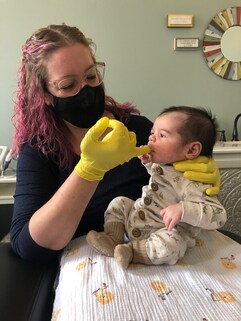|
Dr.Jack Newman - September 24, 2013 · The following is from a blog by a mother who tested her milk for alcohol. Not one of those useless kits that you can buy at various stores, but tested at a toxicology laboratory. I will copy from her blog the method she used and the results. I think this puts the lie to the notion that women should not drink while breastfeeding or need to "pump and dump" (an appalling term) after having even one drink. The following is an exact quote from her blog:
Method: First I took a sample of my milk (about 1 mL) prior to drinking any alcoholic beverage. I expressed the milk mid-nursing session to ensure I had a goodly portion of fore & hind milk. After completing the nursing session, I mixed myself an alcoholic beverage consisting of 2 oz of 80 proof (40%) vodka in 10 oz of soda (Sprite). I proceeded to drink the entire 12 oz in about 30 minutes. About 30 minutes after finishing (1 hour after beginning to drink), I expressed some milk (about 1 mL) and labeled it 'immediate'. I then waited 1 hour and expressed more milk (about 1 mL) and labeled it '2 hours'. In the 2 hours (from the beginning), I did not drink any more alcoholic beverages, drink other beverages, or eat any other foods. Another day, 1/2 of a beer (4.3% alcohol) and 2-6 oz glasses of wine were consumed within 1.5 hours. About an hour from the beginning of the last drink, a milk sample (about 1 mL) was taken. This sample was labeled '1 hour - 3 drinks'. Another sample was taken about an hour after that (2 hours after the beginning of the last drink). This sample was labeled '2 hours - 3 drinks'. The samples were stored in the refrigerator until processing. An Agilent headspace instrument was used to run the tests. Propanol and ethanol standards were also tested to ensure the instrument was within limits. The instrument is maintained by the KSP Lab Toxicology Section and used in forensic determinations of blood and urine alcohol content. Results: The sample labeled as 'immediate' registered as 0.1370 mg/mL which correlates to 0.01370% alcohol in the sample. The sample labeled '2 hours' registered as 0.0000 mg/ml which correlates to 0.0000%. The sample labeled '1 hour - 3 drinks' registered as 0.3749 mg/mL which correlates to 0.03749% alcohol in the sample. The sample labeled '2 hours - 3 drinks' registered as 0.0629 mg/mL which correlates to 0.00629% alcohol in the sample. Conclusion: The alcohol content in breast milk immediately after drinking is equivalent to a 0.0274 proof beverage. That's like mixing 1 oz of 80 proof vodka (one shot) with 2919 oz of mixer . By the way, 2919 oz is over 70 liters. Two hours after drinking one (strong) drink the alcohol has disappeared from the sample. Completely harmless to the nursing infant. Drinking about 3 drinks in 1.5 hours resulted in higher numbers, but still negligible amounts of alcohol would be transferred to the child. One hour after imbibing in 3 drinks, the milk was the equivalent of 0.07498 proof beverage. That would be like adding 1 oz of 80 proof vodka (one shot) to 1066 oz of mixer (1066 oz is over 26 liters). Two hours after imbibing in 3 drinks, the milk was 0.01258 proof. That would be like adding 1 oz of 80 proof vodka to 3179 oz of mixer (over almost 80 liters). So, even though an infant has much less body weight, any of these percentage of alcohol in breast milk is unlikely to adversely affect the baby. Bottoms up!
1 Comment
From The Womanly Art of Breastfeeding, 8th Edition by La Leche League International (c) 2011
The only thing I have to add to the above recommendations is to make the baby "work" for "letdown" while bottle feeding so that they have to suck that first stimulatory suck that they do when they latch onto the breast, which triggers the mother to let down. After a minute or so you can allow the nipple to get more milk to simulate letdown. After several minutes there, tilt the bottle backwards again so they have to "work" for another "letdown" and continue until the baby is finished (NOT necessarily until the bottle is empty). For folks who need some rules to follow- general rules of thumb include no more than once ounce per hour, and it's a good idea to have 20-30 minutes be the goal to finish the bottle. If the baby is finishing the bottle in less time than that, their stomachs won't have enough time to communicate to their brains that they're full. Slow feeds more accurately replicate breastfeeding so they prevent both overfeeding and flow preference! It's generally much better to offer smaller amounts more frequently (i.e. 1.5-2 ounces every 1.5-2 hours) than larger amounts less often (i.e. 3-4 ounces every 3-4 hours). |
Archives
March 2022
Categories
All
|
HO*LIS*TIC ~ADJECTIVE: Relating to or concerned with complete systems rather than with individual parts
WNY Orofacial & Breastfeeding Support Center is a division of Holistic Parenting Network, LLC, located within the village of East Aurora, NY.
131 Orchard Park Rd. West Seneca, NY 14224 fax: (716) 508-3302 (716) 780-2662 [text friendly]
WNY Orofacial & Breastfeeding Support Center is a division of Holistic Parenting Network, LLC, located within the village of East Aurora, NY.
131 Orchard Park Rd. West Seneca, NY 14224 fax: (716) 508-3302 (716) 780-2662 [text friendly]


 RSS Feed
RSS Feed